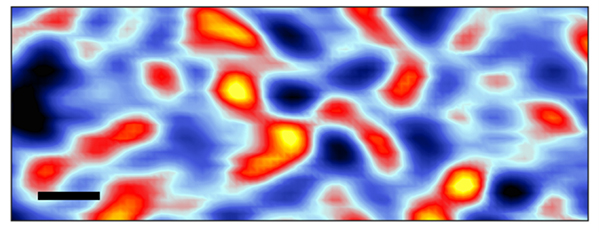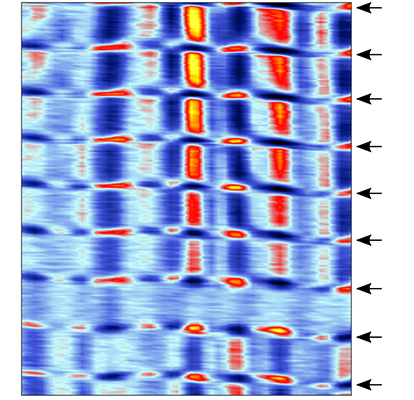Are you a journalist? Please sign up here for our press releases
Subscribe to our monthly newsletter:

It is not too difficult to separate a positive electric charge from a negative one, but the same cannot be done, in nature, for the two ends of a magnet: Each pole is inseparable from its opposite. A group at the Weizmann Institute of Science not only created a sort of magnetic monopole – one that is only “north” or “south” – they measured it precisely and then, conducting further experiments, added some surprising new details to the picture of how spontaneous currents and magnetic fields are created in topological materials. Their findings were recently reported in Nature Physics.
In their experiment, Aviram Uri and Dr. Sameer Grover, along with other members of Prof. Eli Zeldov’s group in the Institute’s Condensed Matter Physics Department, used what’s known as a topological material – a material that, no matter how it is shaped, cut or etched, will always be an insulator inside and a conductor on its surfaces or edges. In theory, topological materials could add a twist to a knowneffect in regular metals: When you bring a small electric charge above the surface of a metal, a cloud of oppositely-charged particles gathers on the surface. From above, it appears as if an equal and opposite charge forms below the surface. In metals both charges are electric, but unique properties of certain topological materials could, according to the theory, cause a response that mimics a magnetic monopole charge formed below the surface rather than an electric one. Despite numerous attempts, this response had not been detected, says Zeldov, because researchers had no way to measure such extremely small-scale effects.
Zeldov, however, did have a means of measuring this effect: the Superconducting QUantum Interference Device, or SQUID, developed in his lab, which is fabricated on a sharp tip. This SQUID-on-tip, or SOT, is an ultra-sensitive magnetometer that has nanoscale resolution. The researchers used a clever trick to measure the effect: With the same device, they applied an electric charge close to the sample’s surface and at the same time measured the minute magnetic response.

First, the Weizmann researchers, in collaboration with Dr. Youngwook Kim and Prof. Jurgen Smet from the Max Planck Institute for Solid State Research in Stuttgart, Germany, applied a large external magnetic field to graphene – a single layer of carbon atoms – inducing a so-called quantum Hall effect that turned the graphene into a certain kind of topological material. Then, using the SOT, the researchers found that they could, indeed, create and measure a magnetic “mirror image” in response to an electric charge near the graphene’s surface. Like the mirage of the opposing electric charge, this magnetic one originated with electrons within the material, but behaved like the real thing. “We demonstrated that two phenomena – electricity and magnetism – that are not normally connected in this way get cross-linked in topological materials,” says Zeldov.
The researchers found that they could, indeed, create and measure a magnetic “mirror image”
How does this happen? To understand what the researchers observed, one needs to understand something about the quantum Hall effect. By increasing the electron density in the material, one can switch it back and forth between topologically-insulating and metallic states. Each topological state can be thought of as a kind of “pretzel”: Each level adds another hole “punched” in the pretzel. In the graphene’s topological state, electrons circulate along its edges, and the researchers found that these currents exist even when no external electricity is applied, flowing indefinitely without dissipation.
These experiments revealed something that was, at first, a surprise to the researchers. Once again, the SOT, which is sensitive enough to measure these circulating currents, helped them to zoom in on what was happening at the edges. “In the quantum Hall state, the currents are expected to be chiral – that is, to circle along the edges in one direction in a number of parallel channels, determined by the number of ‘holes in the pretzel’,” says Zeldov. “We found, however, that each channel carries a pair of counter-propagating currents side by side arising from different origins – one topological and the other non-topological.”
An extensive theoretical analysis of these results, in collaboration with Dr. Cyprian Lewandowski of the Massachusetts Institute of Technology (MIT), shed new light on this puzzle. In the topological state, the circulating currents flow such that the electrons’ movements produce a response in the form of magnetic monopole beneath the surface. But when in the non-topological (metallic) state, the currents circulate in the opposite direction, creating an opposite magnetic field that mimics a dipole, rather than a monopole.

“Although these phenomena had been predicted in the 1990s,” says Zeldov, “they have mostly been ignored. Now that we have performed the experiments, physicists investigating topological states such as the quantum Hall effect and topological insulators or semimetals may have to take into account a more complex picture of these quantum effects.” Among other things, the findings may have implications for comprehension of quantum heat transport and development of devices for high precision measurement of quantum resistance.
Also participating in this study were Dr. Kousik Bagani, Nadav Auerbach, Dr. Ella O. Lachman, and Dr. Yuri Myasoedov of the Weizmann Institute of Science’s Condensed Matter Physics Department.
Prof. Eli Zeldov's research is supported by the Willner Family Leadership Institute for the Weizmann Institute of Science; and he is Head of the Joseph H. and Belle R. Braun Center for Submicron Research and of the the Gruber Center for Quantum Electronics; his research is also supported by the Andre Deloro Prize for Scientific Research; the Leona M. and Harry B. Helmsley Charitable Trust; the Sagol Weizmann-MIT Bridge Program; and the Goldfield Family Charitable Trust. Prof. Zledov is the incumbent of the David and Inez Myers Professorial Chair.